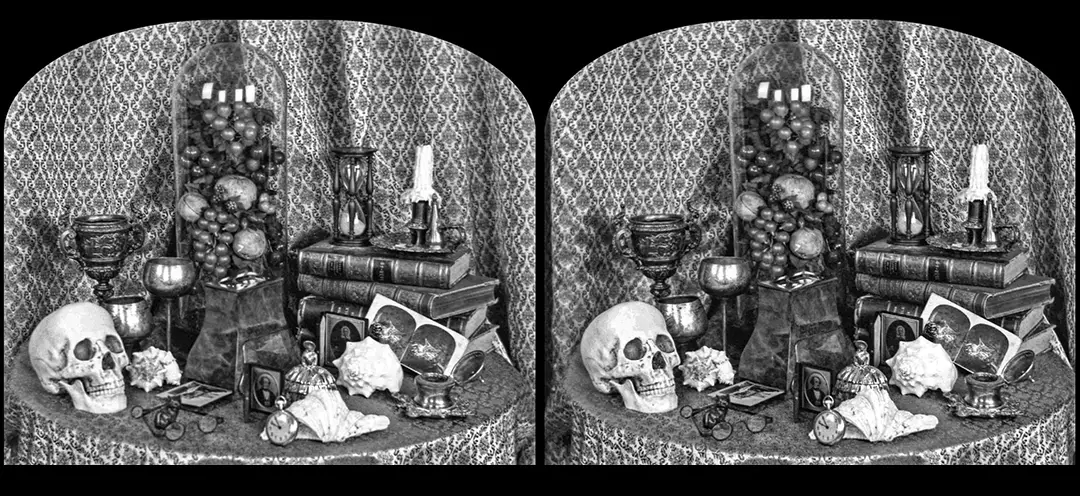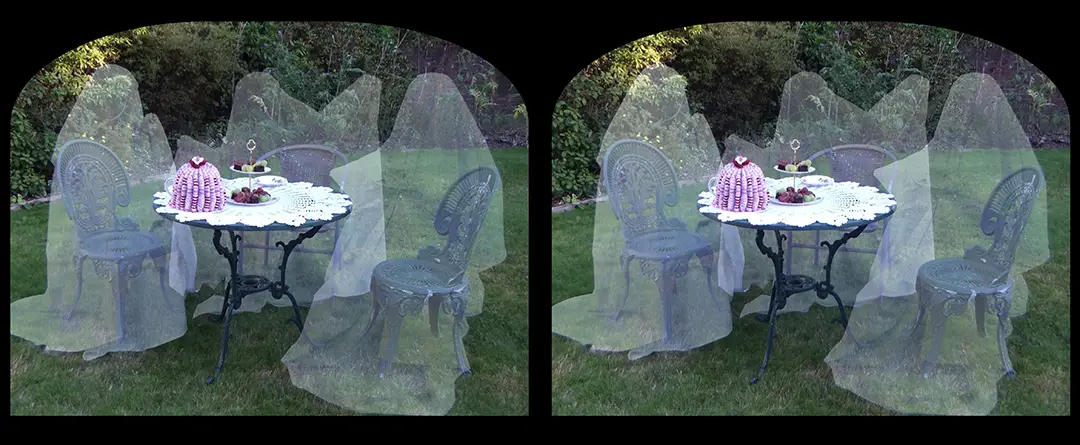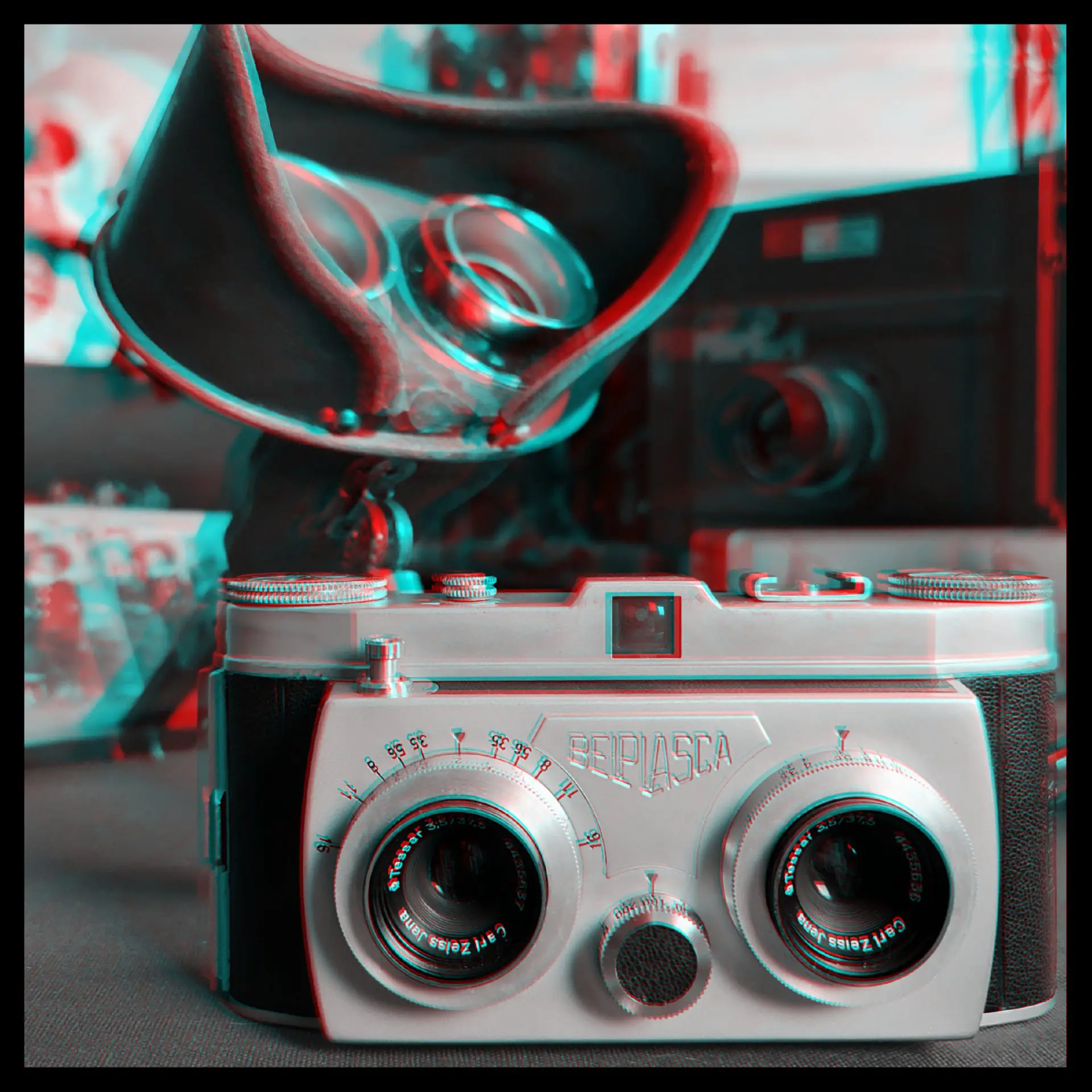I started the Stereoscopy Blog back in May 2019 after I was frequently contacted by people who wanted to get involved in stereoscopy but didn’t know where to start. There were already a few websites and clubs, but they seemed to go straight from zero to overly technical and expected immediate perfection, even before you’d worked out how to pronounce stereoscopy. They also usually focused on just one particular aspect, when in reality stereoscopy is multifaceted; it can be entertaining, artistic, educational and, above all, enjoyable. It also has several different applications.
I guess many readers might be asking what this lass is harping on about with stereoscopy; I understand it’s quite a niche area of photography, so please let me explain.

What is Stereoscopy?
Stereoscopy, or stereoscopic 3D, creates the illusion of depth from two flat images photographed, or drawn, from two slightly different angles, roughly correlating to the human eyes. As each perspective is presented to each eye separately the brain interprets the two, fuses them, and one three-dimensional image is formed. These images can be seen in 3D either by ‘free-viewing’ or using devices, such as anaglyph filters and glasses, polarising 3D TVs and glasses, or a stereoscope. Stereoscopy mimics what the human eyes and brain are doing during every waking moment. The pair of images below, for example, will appear in 3D when viewed with a stereoscope, or if you can learn how to ‘free-view’ with the naked eye.

A Very Brief History of Stereoscopy and its Application to Photography
Stereoscopy was invented in 1832, before photography, but its application to photography turned it into a powerful instrument. It allowed people to experience parts of the world where they had never set foot before as if they were standing in the moment the shutter(s) had captured. They could see all the beautiful details, depth, and textures of architecture, which may no longer have existed. They felt as if they could reach out and touch royalty, celebrities, strangers, or friends and family alike. They could virtually attend events and exhibitions which they weren’t able to travel to or had long since closed their doors. It was used as a teaching aid, showing 3D anatomy to countless students. It brought theatricals and famous paintings to life in people’s own homes. Later, it also documented the many tragedies of war, giving an intense experience of the realities, whilst also allowing aerial identification of structures in the topography. We are still able to step into all of these moments today and feel as if we are in a time machine, thanks to stereoscopic images being the first commercial mass-production of photography. We are also still able to harness this technology, using even basic equipment, to continue to capture the world around us in 3D.

The pioneering stereoscopic photographers used a single-lens camera and made two long exposures of the same scene, moving the camera laterally between shots for the left-eye and right-eye perspectives. Later came binocular stereo cameras, enabling the capture of ‘instantaneous moments’ in 3D. Exposure times shortened as photography advanced over the years, equipment and kits became more readily available and affordable, and eventually, more amateur photographers started to get involved.
The introduction of Kodachrome film really began an explosion of amateur and popular stereoscopic photography, particularly with the introduction of the affordable Stereo Realist and similar stereo cameras in the late 1940s – early 1950s. Kodachrome also gave us the View-Master reels and viewers, which remained popular for many decades afterwards, bringing stereoscopy back into countless homes. It was thanks to one of these amazing little devices that my own interest in stereoscopy was sparked in my childhood. Ultimately, it sent my nerdiness off the scale a few years later when I threw myself headfirst into the different aspects of stereoscopy.

Stereo film cameras’ popularity began to decline in the 1970s, but then along came the quadrascopic cameras, the Nimslo and the Nishika. They made lenticular printing accessible to the public, although they didn’t achieve the success of their twin-lens relatives, and the printing service was eventually discontinued. The digital photography revolution also happened, but compact digital stereo cameras didn’t arrive on the scene until around 2010, with only two manufacturers making them readily available. Coupled with 3D TVs, which were still produced at the time, the Fujifilm FinePix Real 3D cameras were very popular, even beyond their manufacturer’s expectations, but were discontinued relatively soon afterwards.

Stereoscopy has also been used in the cinema, with one of the pinnacle popular moments being the release of Avatar in 3D. 3D Blu-rays, which were popular, are currently in steep decline as 3D TVs have since been discontinued, and relatively few films are released in 3D now. It has also been used in VR, especially for gaming and design, and its principles are used in social media, such as for Facebook’s 3D photos option. This still gives a need and use for the inclusion of related technology in smartphones, such as the iPhone’s Lidar sensor, or other scanning apps; this technology also has other applications outside of social media, especially for architecture and design. Smartphones themselves have apps available to help anyone create their own stereoscopic images without specialist technology, which is usually by taking sequential photos, like the pioneering stereo photographers.

Throughout the history of stereoscopy and stereoscopic photography though, you will see there is a pattern of peaks and troughs of popularity; there’s a sudden craze as something new comes along, but then a decline, and eventually discontinuation. There are, however, still exciting projects which crop up using the principles of stereoscopy, such as glasses-free displays, including light-field ‘holographic’ technology. Currently, there’s a Kickstarter campaign to create a new stereoscopic compact digital camera, and time will tell if it takes off like its predecessors.
There have always been dedicated individuals in the background of the popular crazes who have kept stereoscopic photography alive and brought it to new audiences. They often find their own custom ways of overcoming the obsolescence of once-popular technology, usually by reusing old equipment and methods and mixing it with modern technology.
Finding Your Own Enjoyment in Stereoscopy
My personal enjoyments in stereoscopy include its ability to bring history to life and add so much more information and immersion than mono photography. I also really enjoy using it with my own photography, particularly film photography, bringing modern moments to life and being able to share them in 3D with others. It feels like a magical reward when you’ve spent the time to take the photos, process the films and finally see the results in 3D. Digital stereo photography is relatively convenient and quick, but I find that seeing film slides through a 3D viewer is a really different experience and worth all the extra effort.
Everyone has their own preferences for which elements of stereoscopy they enjoy, and how. Remember that it’s not just a one-dimensional hobby (pun intended), and if you check out the Blog you’ll see there is more to it than meets the eyes (another pun intended, sorry).


Why Isn’t Everything Photographed in 3D and Where Do I Start?
You’re probably wondering if stereoscopic photography is so amazing, then why isn’t everyone still doing it? I have already mentioned the difficulties with the availability of technology, as it’s usually discontinued after a while. I also have to be honest with you and say, especially with film, it’s time-consuming, and, in this fast-paced world, not too many people want to spend the extra time, or cost, to reap the 3D rewards. Digital stereo photography can take seconds using a smartphone, an app, and a viewer if necessary. If you then want to share the images, you have to start considering things like: Which format is best for others? Which devices can show the images in 3D? Which apps can be used to align the images? Can you still buy a twin-lens digital camera?

Stereoscopic film photography can be even more complicated. The cameras are usually second-hand, so you’re often at the mercy of the likes of eBay sellers saying they are fully working (which I’m sure many of you are aware of with second-hand mono cameras). The cost of slide film and processing it now makes your eyes water. And once all that is out of the way, then you have to work out how you’re going to mount it to make it into a stereo slide. Where do you find the mounts? How do you mount the film? What do you view it with? Can you use negative film instead? What camera should you look out for? Can you use a single-lens camera? What are the frame formats like? Will a lab process it for you? Can you scan it and make digital stereoviews?


Introduction to the Stereoscopy Blog
Fear not. I really want to encourage everyone to join in and make stereoscopy as accessible as possible. That’s one of the main aims of the Stereoscopy Blog, which is a free resource open to everyone, and another reason why I started it. On the Blog, you will find several general posts about stereo photography, such as how to view stereoscopic images, how to use the free software StereoPhoto Maker, upcoming events and workshops. Posts about film photography, including how to get started, film camera reviews, others experiences with stereo film photography. You can also find posts about digital stereo photography and processing, such as how to make stereoviews with your smartphone, examples of twin digital camera rigs, how to make stereoviews using Photoshop, how to make Wigglegrams with Photoshop.

Everyone has their own preference for how they want to learn about the different aspects of stereoscopy which appeal to them. The Blog aims to give everyone the breathing space to pick things up at their own pace, in their own time, at the level they want, whilst demystifying the voodoo that is stereoscopy. You can be as involved and technical as you want to be with stereoscopic photography. I want to encourage total beginners, as well as those who have stereo-cameras collecting dust to pick them back up and get involved. I also want to show other everyday stereo photographers that they’re not on their own, we’re a relatively small but thriving community. We also have A LOT of 3D kitties to draw you in.

Although I’m very fortunate to work full-time in the world of stereoscopy, I still consider myself an enthusiastic amateur stereo photographer, but I will always help everyone as much as I can. I also have a great network of friends with lots of experience and knowledge to who I can refer people when needed. I really want to help inspire everyone to join in and if there’s anything you’re unsure about and need further advice, or want to request a post about something, you can always contact the Blog.
I hope you’ll be immersed in the enjoyment of stereoscopic 3D photography soon!
Rebecca
www.stereoscopy.blog

Share this post:









Comments
Rich on An Introduction to Stereoscopic (3D) Photography, and the Stereoscopy Blog – By Rebecca (from Stereoscopy Blog)
Comment posted: 02/03/2022
I wonder if anyone has made a stereoscopic pinhole camera!? (Just idle curiosity ????)
--Rich
Comment posted: 02/03/2022
Bud Sisti on An Introduction to Stereoscopic (3D) Photography, and the Stereoscopy Blog – By Rebecca (from Stereoscopy Blog)
Comment posted: 03/03/2022
Comment posted: 03/03/2022
D Evan Bedford on An Introduction to Stereoscopic (3D) Photography, and the Stereoscopy Blog – By Rebecca (from Stereoscopy Blog)
Comment posted: 03/03/2022
Then, for my personal pleasure, I like to go out to the mountains with a Nikon F6 and a zoom lens and take photos using the cha-cha method, but instead of 2 images taken only a foot apart, I'll take two photos of a distant mountain scene perhaps 20m or 50m apart. I then use stereophotomaker software to align the photos, print them on 4x6 paper and view them under a mirrored stereoscope. The effect is like looking at a diorama that has incredible detail.
I also use a Fuji W3 on holidays, but I prefer the effect of the wide parallax images. It looks like I can reach out and touch a mountain or the far side of a valley with my finger.
Comment posted: 03/03/2022
Comment posted: 03/03/2022
Comment posted: 03/03/2022
Bill Thoo on An Introduction to Stereoscopic (3D) Photography, and the Stereoscopy Blog – By Rebecca (from Stereoscopy Blog)
Comment posted: 05/03/2022
Comment posted: 05/03/2022
William Hamblen on An Introduction to Stereoscopic (3D) Photography, and the Stereoscopy Blog – By Rebecca (from Stereoscopy Blog)
Comment posted: 05/03/2022
Comment posted: 05/03/2022
Top 10 3d Photo Camera Answers | ALL-TECH-STORE on An Introduction to Stereoscopic (3D) Photography, and the Stereoscopy Blog – By Rebecca (from Stereoscopy Blog)
Comment posted: 24/06/2022
Ross on An Introduction to Stereoscopic (3D) Photography, and the Stereoscopy Blog – By Rebecca (from Stereoscopy Blog)
Comment posted: 02/08/2022
Comment posted: 02/08/2022
Bill Thomson on An Introduction to Stereoscopic (3D) Photography, and the Stereoscopy Blog – By Rebecca (from Stereoscopy Blog)
Comment posted: 31/07/2023
Comment posted: 31/07/2023